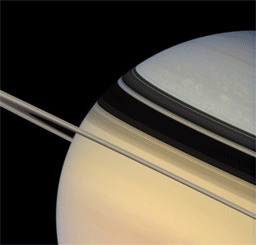Emily Lakdawalla • Jan 03, 2008
Amazing Saturn ring-plane crossing animation
Here's another stunner from Cassini. The animation below spans not quite three hours and shows Cassini's shifting view as it crossed Saturn's ring plane on February 4, 2007. The thumbnail version below doesn't do it justice; you really need to download the full-res version to appreciate it in all its glory, though at 3.2 MB it's a bit big for those of you who read this page over a dialup connection.

NASA / JPL / SSI / Gordan Ugarkovic
Cassini crosses Saturn's ring plane, February 4, 2007
Twice each orbit, Cassini crosses through the plane of Saturn's rings. This crossing, on February 4, 2007, was from the south to the north, from the lit to the unlit side of the rings. The animation, presented in approximately true color, shows how the rings are (unsurprisingly) much darker when viewed from their unlit side than when viewed from the lit side. This 11-frame animation was created from frames taken by Cassini's wide-angle camera through red, green, and blue filters; the frames are 20 minutes apart, so the whole animation spans two hours and 40 minutes. During that time, Saturn rotates nearly a quarter turn, which can be seen in the motions of clouds in the northern latitudes. At the very end of the animation, a bright dot -- the moon Enceladus -- appears on the far side of Saturn's rings. In the full-resolution version of the animation (GIF format, 3.2 MB), Epimetheus is also visible, running ahead of, and faster than, Enceladus.This animation comes from data newly released to NASA's Planetary Data System, or PDS. Cassini (like all NASA missions) is required to send quarterly batches of data to the PDS, covering all data acquired nine months to a year prior, so the January 1, 2008 release of Cassini data contains everything that it did from January 1 to March 31, 2007. Of course, Cassini images are made available to the public much more quickly through the Cassini raw images website -- you can go there to get pictures that are only hours old -- but those "raw" images are somewhat reduced in quality from the versions that the mission keeps on their computers. In particular, they've all been run through an algorithm that stretches the contrast to make the lightest-toned pixels white and the darkest ones black, which makes it MUCH easier to see what's going on in an individual image, but also, unfortunately, makes it impossible to combine the raw images and get anything like true color. The raws have also been compressed by conversion to JPEG format, which makes the images download to your computer MUCH faster (the original data occupies 2 Megs per picture, while the JPEGs usually come in at less than one percent of that), but JPEG compression introduces unsightly artifacts into the images. To get approximately true colors and the prettiest pictures out of Cassini image data, you have to be a little patient, and wait that nine to twelve months to dig the photos out of the PDS. One guy who always watches the Cassini PDS releases carefully is space enthusiast Gordan Ugarkovic, whose fine work I've posted here before, and who is responsible for the animation above.
Support our core enterprises
Your support powers our mission to explore worlds, find life, and defend Earth. You make all the difference when you make a gift. Give today!
Donate

 Explore Worlds
Explore Worlds Find Life
Find Life Defend Earth
Defend Earth

